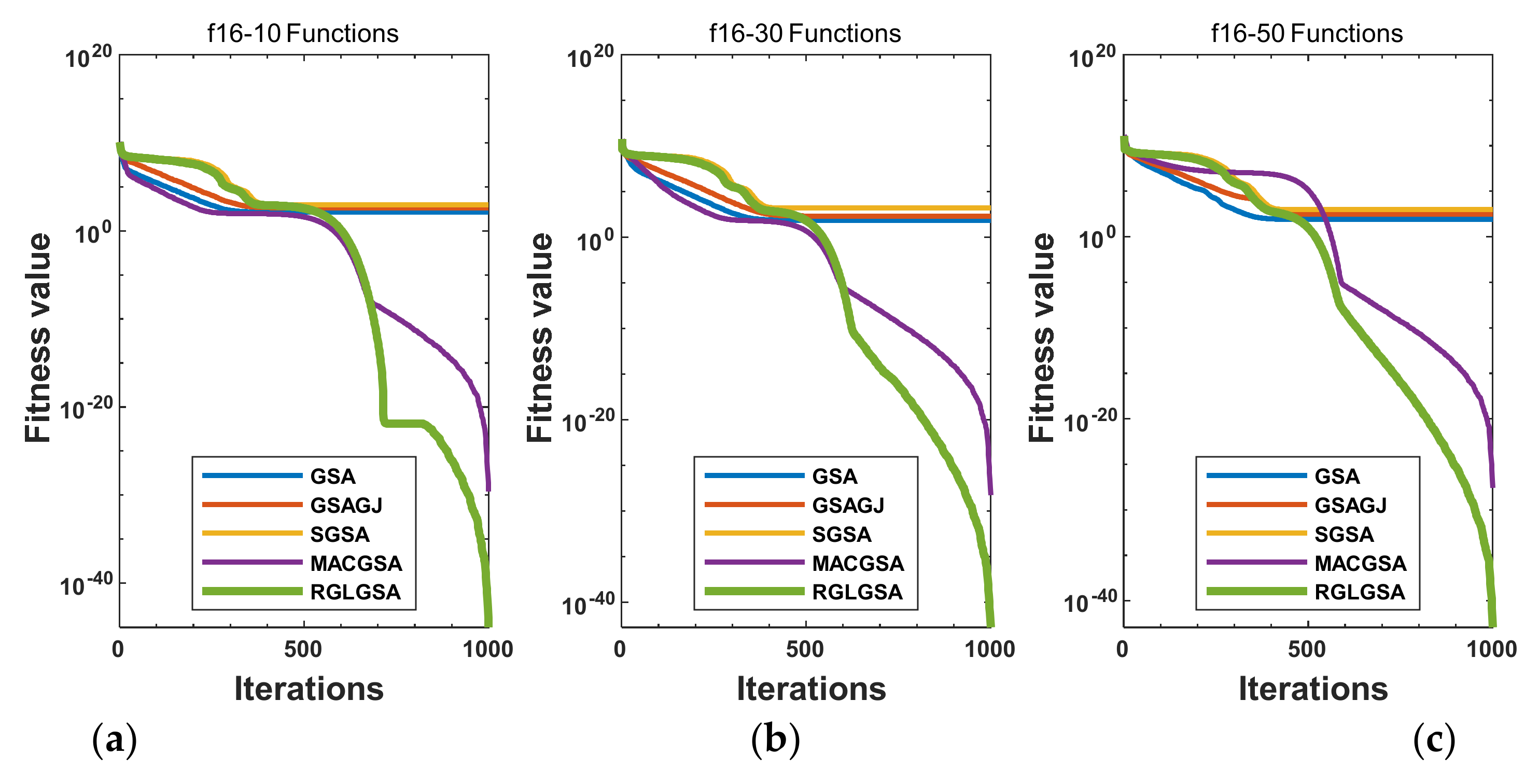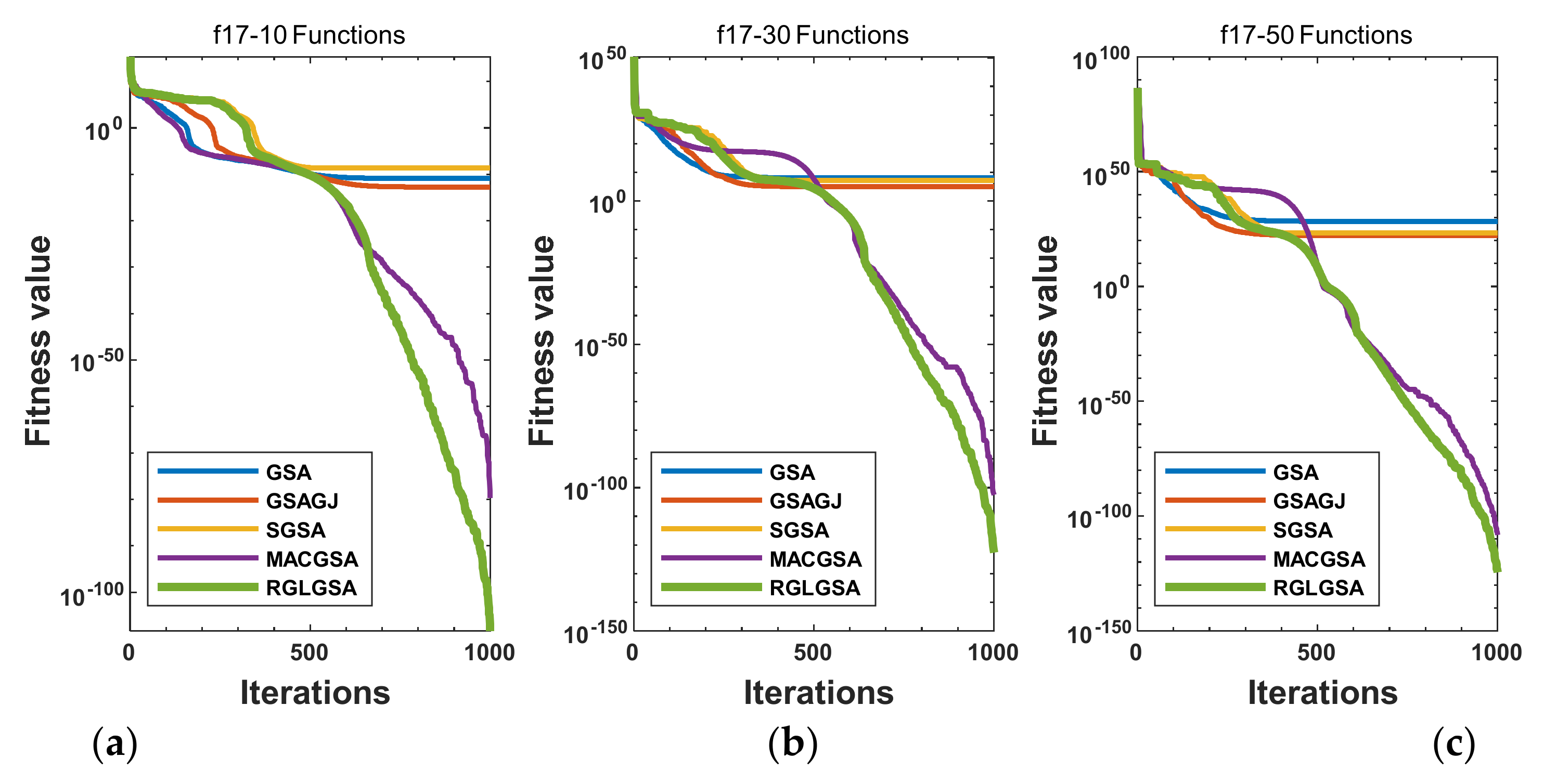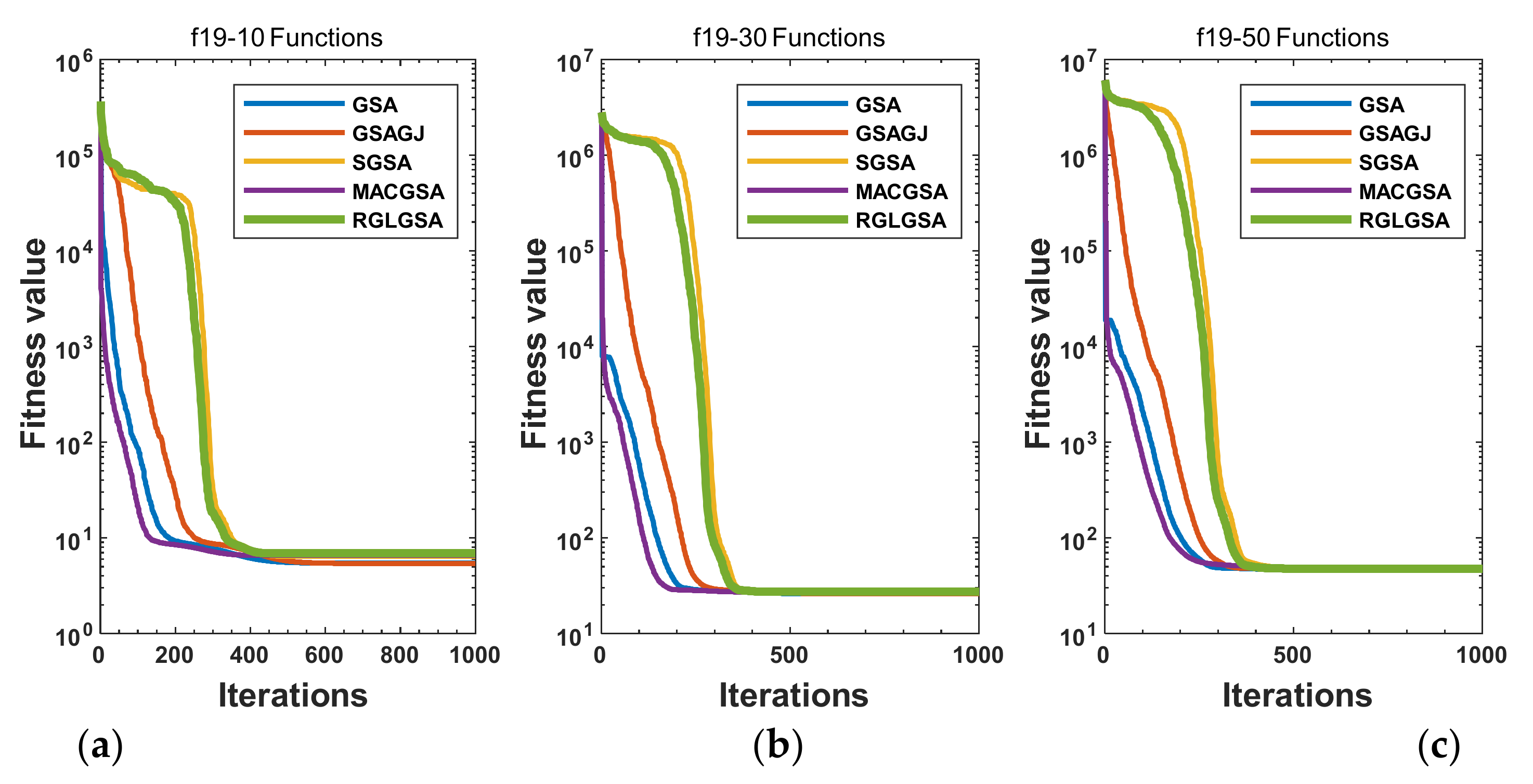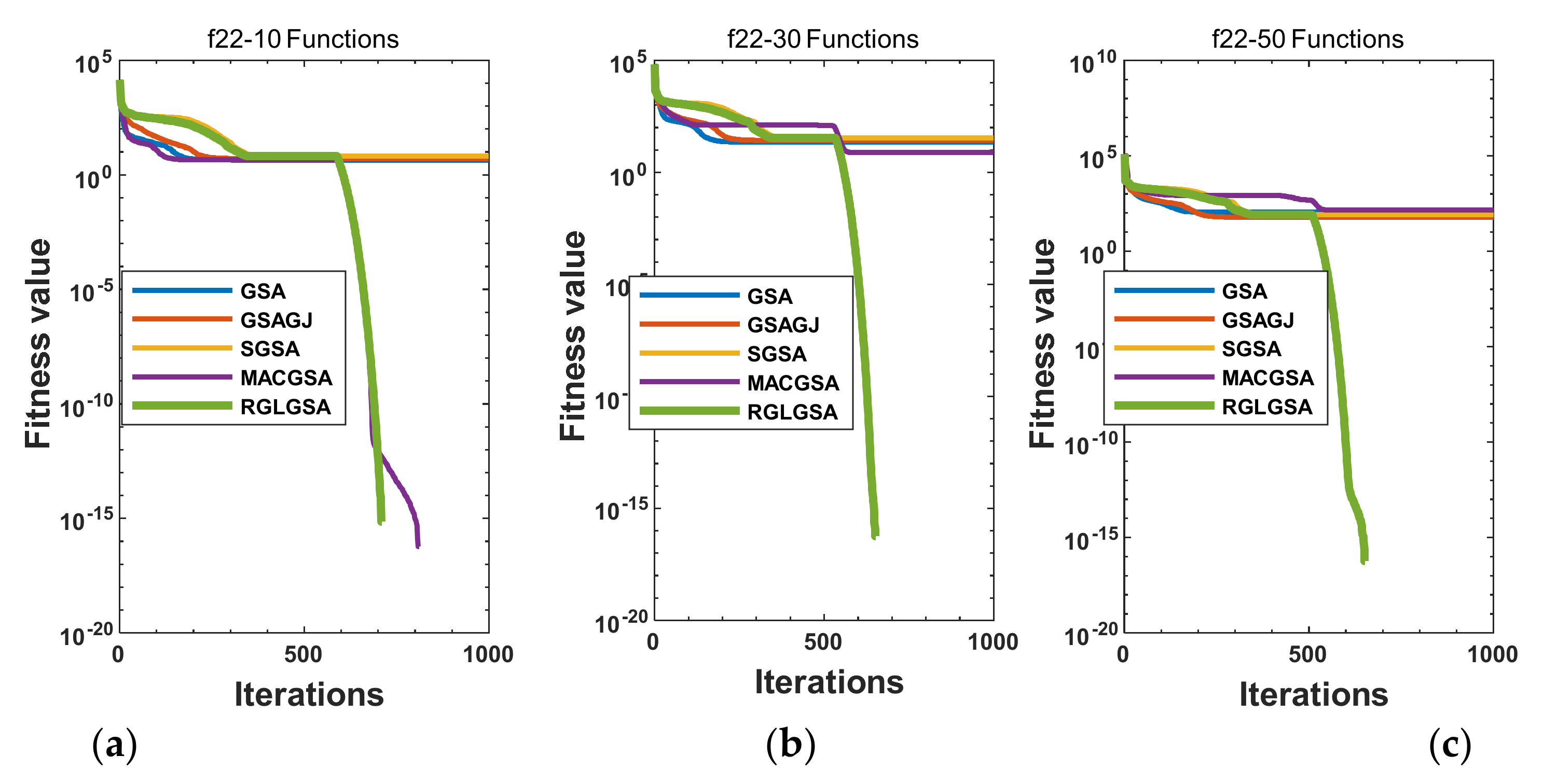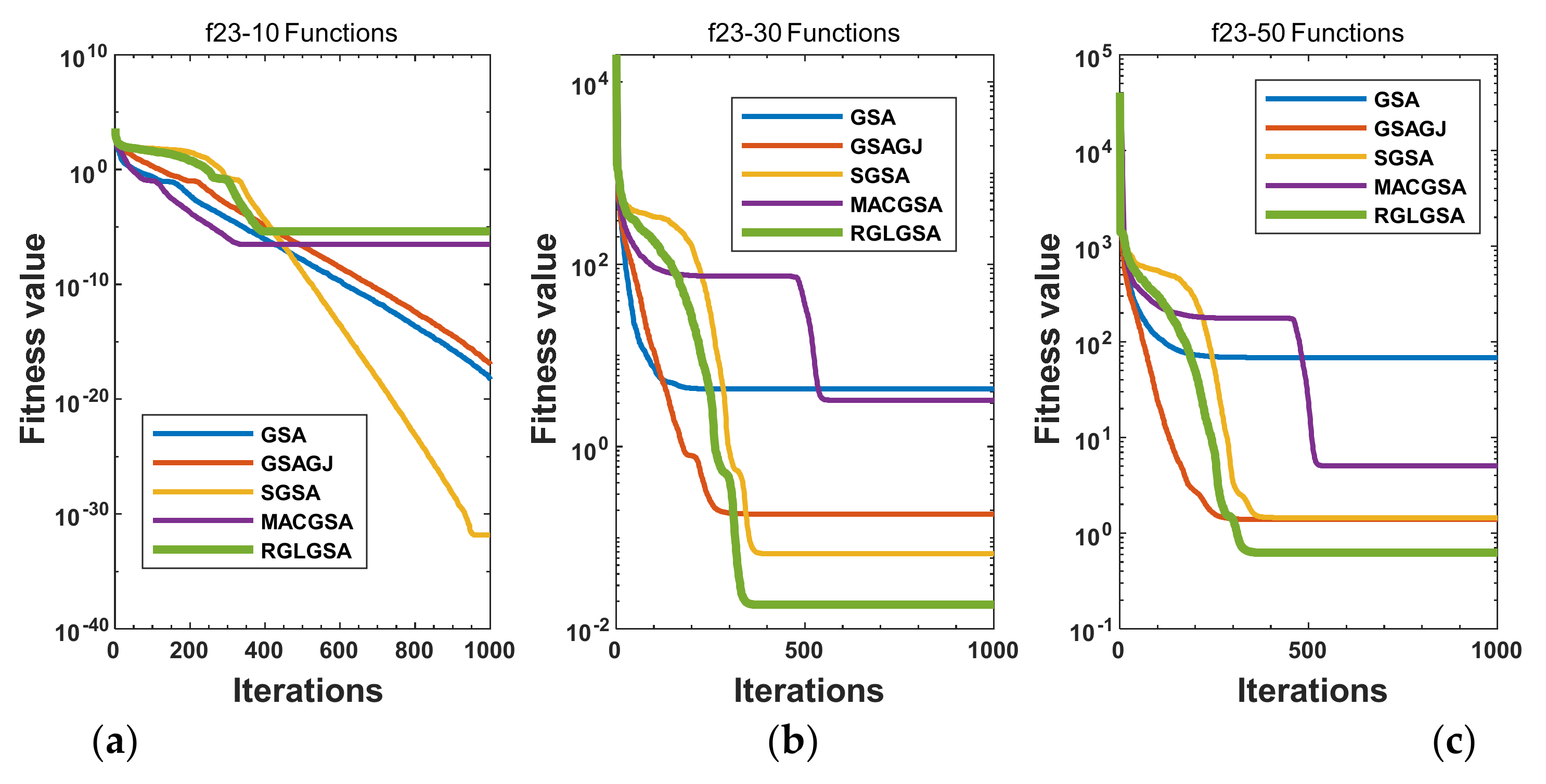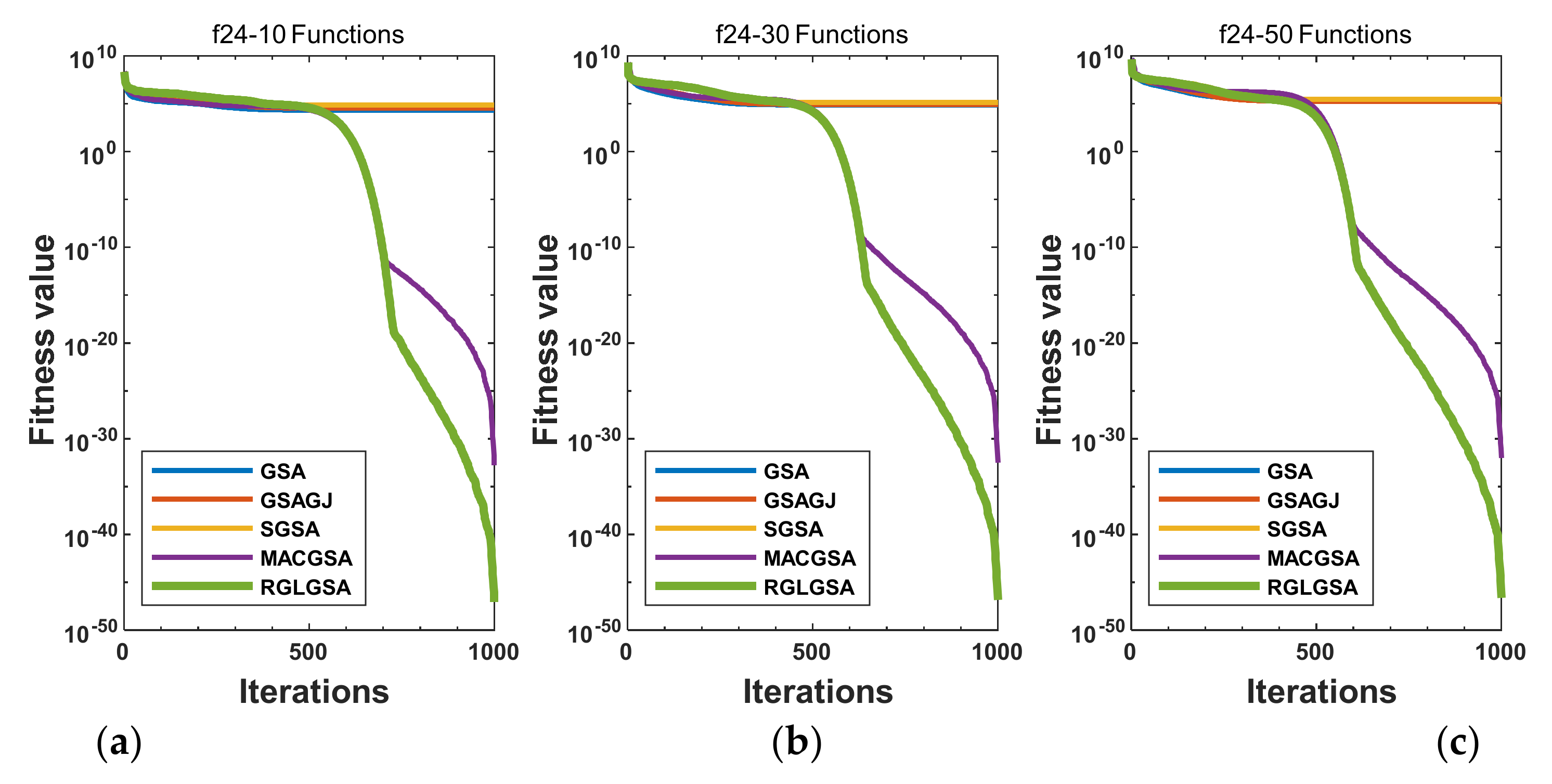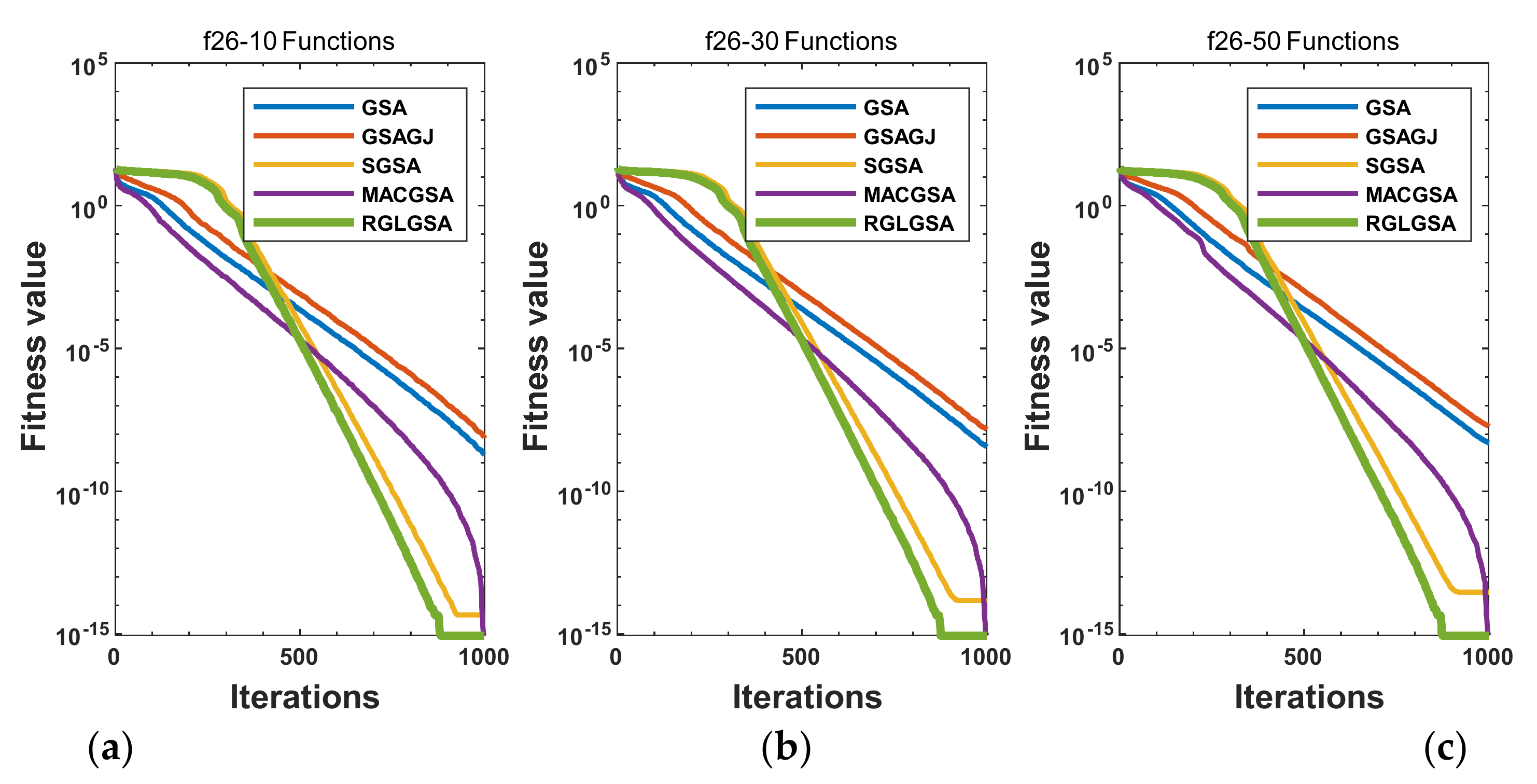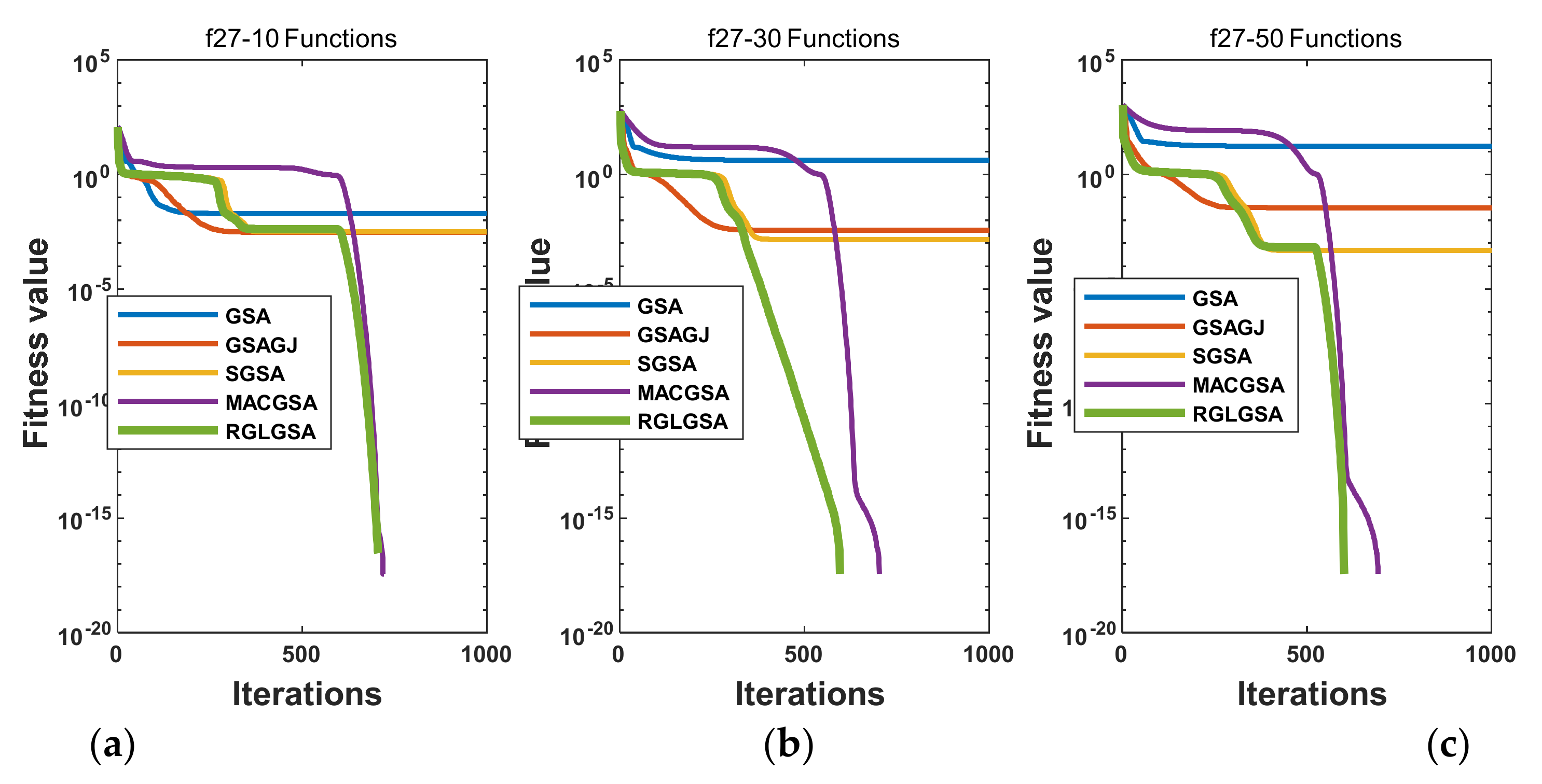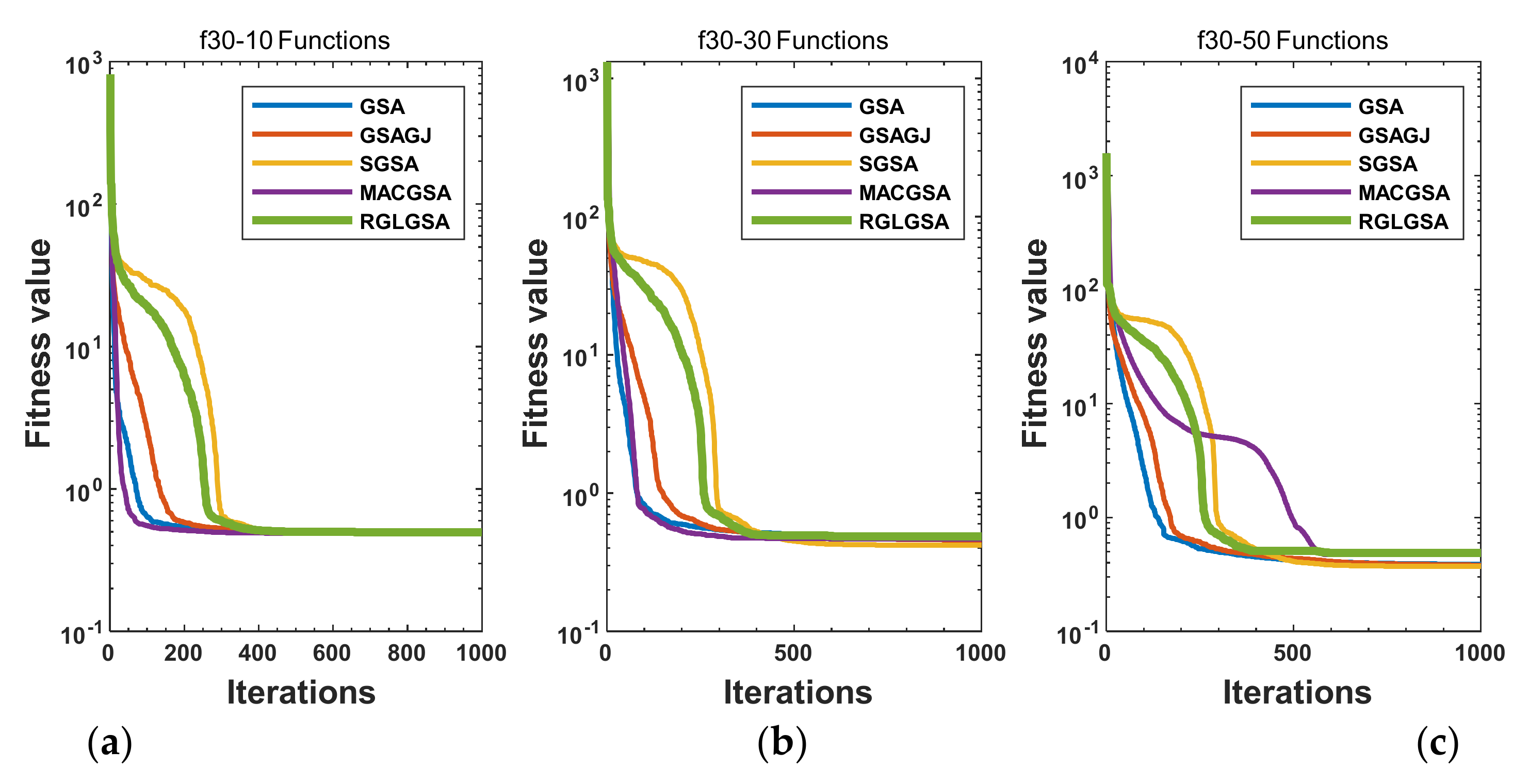Figure 1.
Convergence curves of function f16: (a) 10 dimensions, (b) 30 dimensions, and (c) 50 dimensions.
Figure 1.
Convergence curves of function f16: (a) 10 dimensions, (b) 30 dimensions, and (c) 50 dimensions.
Figure 2.
Convergence curves of function f17: (a) 10 dimensions, (b) 30 dimensions, and (c) 50 dimensions.
Figure 2.
Convergence curves of function f17: (a) 10 dimensions, (b) 30 dimensions, and (c) 50 dimensions.
Figure 3.
Convergence curves of function f18: (a) 10 dimensions, (b) 30 dimensions, and (c) 50 dimensions.
Figure 3.
Convergence curves of function f18: (a) 10 dimensions, (b) 30 dimensions, and (c) 50 dimensions.
Figure 4.
Convergence curves of function f19: (a) 10 dimensions, (b) 30 dimensions, and (c) 50 dimensions.
Figure 4.
Convergence curves of function f19: (a) 10 dimensions, (b) 30 dimensions, and (c) 50 dimensions.
Figure 5.
Convergence curves of function f20: (a) 10 dimensions, (b) 30 dimensions, and (c) 50 dimensions.
Figure 5.
Convergence curves of function f20: (a) 10 dimensions, (b) 30 dimensions, and (c) 50 dimensions.
Figure 6.
Convergence curves of function f21: (a) 10 dimensions, (b) 30 dimensions, and (c) 50 dimensions.
Figure 6.
Convergence curves of function f21: (a) 10 dimensions, (b) 30 dimensions, and (c) 50 dimensions.
Figure 7.
Convergence curves of function f22: (a) 10 dimensions, (b) 30 dimensions, and (c) 50 dimensions.
Figure 7.
Convergence curves of function f22: (a) 10 dimensions, (b) 30 dimensions, and (c) 50 dimensions.
Figure 8.
Convergence curves of function f23: (a) 10 dimensions, (b) 30 dimensions, and (c) 50 dimensions.
Figure 8.
Convergence curves of function f23: (a) 10 dimensions, (b) 30 dimensions, and (c) 50 dimensions.
Figure 9.
Convergence curves of function f24: (a) 10 dimensions, (b) 30 dimensions, and (c) 50 dimensions.
Figure 9.
Convergence curves of function f24: (a) 10 dimensions, (b) 30 dimensions, and (c) 50 dimensions.
Figure 10.
Convergence curves of function f25: (a) 10 dimensions, (b) 30 dimensions, and (c) 50 dimensions.
Figure 10.
Convergence curves of function f25: (a) 10 dimensions, (b) 30 dimensions, and (c) 50 dimensions.
Figure 11.
Convergence curves of function f26: (a) 10 dimensions, (b) 30 dimensions, and (c) 50 dimensions.
Figure 11.
Convergence curves of function f26: (a) 10 dimensions, (b) 30 dimensions, and (c) 50 dimensions.
Figure 12.
Convergence curves of function f27: (a) 10 dimensions, (b) 30 dimensions, and (c) 50 dimensions.
Figure 12.
Convergence curves of function f27: (a) 10 dimensions, (b) 30 dimensions, and (c) 50 dimensions.
Figure 13.
Convergence curves of function f28: (a) 10 dimensions, (b) 30 dimensions, and (c) 50 dimensions.
Figure 13.
Convergence curves of function f28: (a) 10 dimensions, (b) 30 dimensions, and (c) 50 dimensions.
Figure 14.
Convergence curves of function f29: (a) 10 dimensions, (b) 30 dimensions, and (c) 50 dimensions.
Figure 14.
Convergence curves of function f29: (a) 10 dimensions, (b) 30 dimensions, and (c) 50 dimensions.
Figure 15.
Convergence curves of function f30: (a) 10 dimensions, (b) 30 dimensions, and (c) 50 dimensions.
Figure 15.
Convergence curves of function f30: (a) 10 dimensions, (b) 30 dimensions, and (c) 50 dimensions.
Figure 16.
Convergence curves of function f31: (a) 10 dimensions, (b) 30 dimensions, and (c) 50 dimensions.
Figure 16.
Convergence curves of function f31: (a) 10 dimensions, (b) 30 dimensions, and (c) 50 dimensions.
Table 1.
Test function set.
Table 1.
Test function set.
| Function No. | Test Function | Value Range |
|---|
| 1 | | |
| 2 | | |
| | | |
| 4 | | |
| 5 | | |
| 6 | | |
| 7 | | |
| 8 | | |
| 9 | | |
| 10 | | |
| 11 | | |
| 12 | | |
| 13 | | |
| 14 | | |
| 15 | | |
Table 2.
Test results for f1(x).
Table 2.
Test results for f1(x).
| D | Algorithm | Worst | Best | Mean | SD |
|---|
| 30 | GSA | 3.1784 × 10−17 | 1.1678 × 10−17 | 2.0655 × 10−17 | 4.9762 × 10−18 |
| RGSA | 5.7262 × 10−33 | 4.1402 × 10−34 | 1.0540 × 10−33 | 1.0033 × 10−33 |
| GGSA | 7.8267 × 10−20 | 1.6952 × 10−20 | 4.2861 × 10−20 | 1.5505 × 10−20 |
| LGSA | 1.1171 × 10−27 | 7.0551 × 10−31 | 1.0968 × 10−28 | 2.3663 × 10−28 |
| RGGSA | 2.4777 × 10−38 | 2.4197 × 10−39 | 8.1763 × 10−39 | 4.6307 × 10−39 |
| RLGSA | 4.3833 × 10−48 | 4.9380 × 10−51 | 3.9451 × 10−49 | 9.0845 × 10−49 |
| GLGSA | 2.2316 × 10−29 | 2.3715 × 10−34 | 9.0465 × 10−31 | 4.0589 × 10−30 |
| RGLGSA | 1.1227 × 10−53 | 1.3115 × 10−56 | 1.8360 × 10−54 | 3.3730 × 10−54 |
| 50 | GSA | 1.0370 × 10−16 | 4.2637 × 10−17 | 7.1477 × 10−17 | 1.8306 × 10−17 |
| RGSA | 7.9678 × 10−32 | 4.0968 × 10−33 | 1.7587 × 10−32 | 1.6047 × 10−32 |
| GGSA | 3.1420 × 10−19 | 7.4754 × 10−20 | 2.0370 × 10−19 | 6.3958 × 10−20 |
| LGSA | 7.8808 × 10−28 | 4.8414 × 10−31 | 8.3115 × 10−29 | 1.5517 × 10−28 |
| RGGSA | 1.2945 × 10−35 | 1.7729 × 10−37 | 1.5203 × 10−36 | 2.7454 × 10−36 |
| RLGSA | 3.2260 × 10−48 | 1.9879 × 10−50 | 6.0257 × 10−49 | 7.9558 × 10−49 |
| GLGSA | 2.6738 × 10−30 | 2.0636 × 10−33 | 2.3400 × 10−31 | 5.0105 × 10−31 |
| RGLGSA | 1.4061 × 10−53 | 3.6091 × 10−56 | 2.1920 × 10−54 | 3.3828 × 10−54 |
Table 3.
Test results for f2(x).
Table 3.
Test results for f2(x).
| D | Algorithm | Worst | Best | Mean | SD |
|---|
| 30 | GSA | 2.9944 × 10−8 | 1.8259 × 10−8 | 2.3354 × 10−8 | 2.8498 × 10−9 |
| RGSA | 3.7319 × 10−16 | 1.1320 × 10−16 | 2.2498 × 10−16 | 6.5816 × 10−17 |
| GGSA | 1.5355 × 10−9 | 6.4974 × 10−10 | 1.0641 × 10−9 | 2.3299 × 10−10 |
| LGSA | 5.3312 × 10−14 | 4.3968 × 10−16 | 1.2055 × 10−14 | 1.4035 × 10−14 |
| RGGSA | 1.8821 × 10−17 | 3.8605 × 10−19 | 1.7182 × 10−18 | 3.3370 × 10−18 |
| RLGSA | 5.1586 × 10−24 | 1.0922 × 10−25 | 8.5523 × 10−25 | 9.6857 × 10−25 |
| GLGSA | 1.6789 × 10−15 | 1.0556 × 10−16 | 4.5455 × 10−16 | 3.1838 × 10−16 |
| RGLGSA | 4.8916 × 10−27 | 2.0799 × 10−28 | 1.8049 × 10−27 | 1.2726 × 10−27 |
| 50 | GSA | 0.0236 | 3.7905 × 10−08 | 7.8561 × 10−4 | 0.0043 |
| RGSA | 0.0861 | 6.2460 × 10−16 | 0.0047 | 0.0168 |
| GGSA | 0.2069 | 2.1929 × 10−9 | 0.0181 | 0.0546 |
| LGSA | 5.1145 × 10−14 | 1.2501 × 10−15 | 1.3527 × 10−14 | 1.1082 × 10−14 |
| RGGSA | 0.2833 | 2.7805 × 10−13 | 0.0320 | 0.0748 |
| RLGSA | 3.1275 × 10−24 | 1.8799 × 10−25 | 1.2276 × 10−24 | 8.5222 × 10−25 |
| GLGSA | 2.8762 × 10−15 | 1.3163 × 10−16 | 6.1703 × 10−16 | 5.8851 × 10−16 |
| RGLGSA | 8.7338 × 10−27 | 1.9445 × 10−28 | 2.2760 × 10−27 | 1.8606 × 10−27 |
Table 4.
Test results for f3(x).
Table 4.
Test results for f3(x).
| D | Algorithm | Worst | Best | Mean | SD |
|---|
| 30 | GSA | 4.6203 × 10−9 | 2.0095 × 10−9 | 3.1109 × 10−9 | 7.1216 × 10−10 |
| RGSA | 9.4873 × 10−16 | 5.6256 × 10−17 | 2.5335 × 10−16 | 2.4418 × 10−16 |
| GGSA | 3.0792 × 10−10 | 9.8951 × 10−11 | 2.1632 × 10−10 | 4.9367 × 10−11 |
| LGSA | 3.2172 × 10−14 | 6.3082 × 10−16 | 8.1911 × 10−15 | 8.6301 × 10−15 |
| RGGSA | 0.0167 | 3.0764 × 10−18 | 0.0011 | 0.0041 |
| RLGSA | 4.0438 × 10−24 | 2.3297 × 10−26 | 7.0978 × 10−25 | 8.7193 × 10−25 |
| GLGSA | 2.9153 × 10−15 | 4.4903 × 10−17 | 5.0494 × 10−16 | 6.3364 × 10−16 |
| RGLGSA | 9.4406 × 10−27 | 2.0399 × 10−28 | 1.9853 × 10−27 | 1.9898 × 10−27 |
| 50 | GSA | 7.3060 | 1.4952 | 3.8958 | 1.2656 |
| RGSA | 7.7420 | 1.4171 | 3.8093 | 1.6933 |
| GGSA | 0.0065 | 1.8832 × 10−9 | 2.4286 × 10−4 | 0.0012 |
| LGSA | 2.9909 × 10−14 | 2.6038 × 10−16 | 9.7994 × 10−15 | 8.8800 × 10−15 |
| RGGSA | 1.2411 | 0.3102 | 0.6938 | 0.2702 |
| RLGSA | 6.4042 × 10−24 | 1.3099 × 10−25 | 1.2454 × 10−24 | 1.5236 × 10−24 |
| GLGSA | 5.2383 × 10−15 | 2.7606 × 10−17 | 7.0144 × 10−16 | 1.0081 × 10−15 |
| RGLGSA | 1.0648 × 10−26 | 6.6210 × 10−29 | 3.0313 × 10−27 | 3.1224 × 10−27 |
Table 5.
Test results for f4(x).
Table 5.
Test results for f4(x).
| D | Algorithm | Worst | Best | Mean | SD |
|---|
| 30 | GSA | 4.5997 × 10−9 | 2.5140 × 10−9 | 3.5884 × 10−9 | 4.2747 × 10−10 |
| RGSA | 1.5099 × 10−14 | 7.9936 × 10−15 | 1.0599 × 10−14 | 2.7886 × 10−15 |
| GGSA | 2.5246 × 10−10 | 1.2959 × 10−10 | 1.6997 × 10−10 | 2.7635 × 10−11 |
| LGSA | 9.3259 × 10−14 | 8.8818 × 10−16 | 1.1428 × 10−14 | 1.7165 × 10−14 |
| RGGSA | 1.5099 × 10−14 | 7.9936 × 10−15 | 9.6515 × 10−15 | 2.5945 × 10−15 |
| RLGSA | 8.8818 × 10−16 | 8.8818 × 10−16 | 8.8818 × 10−16 | 0 |
| GLGSA | 4.4409 × 10−15 | 8.8818 × 10−16 | 1.1250 × 10−15 | 9.0135 × 10−16 |
| RGLGSA | 8.8818 × 10−16 | 8.8818 × 10−16 | 8.8818 × 10−16 | 0 |
| 50 | GSA | 6.2569 × 10−9 | 3.7704 × 10−9 | 4.9280 × 10−9 | 6.2123 × 10−10 |
| RGSA | 2.5757 × 10−14 | 1.5099 × 10−14 | 2.0191 × 10−14 | 3.1890 × 10−15 |
| GGSA | 6.4020 × 10−10 | 1.9065 × 10−10 | 2.6571 × 10−10 | 8.2614 × 10−11 |
| LGSA | 2.2204 × 10−14 | 8.8818 × 10−16 | 5.7436 × 10−15 | 4.4239 × 10−15 |
| RGGSA | 0.0193 | 1.1546 × 10−14 | 0.0014 | 0.0043 |
| RLGSA | 8.8818 × 10−16 | 8.8818 × 10−16 | 8.8818 × 10−16 | 0 |
| GLGSA | 4.4409 × 10−15 | 8.8818 × 10−16 | 1.2434 × 10−15 | 1.0840 × 10−15 |
| RGLGSA | 8.8818 × 10−16 | 8.8818 × 10−16 | 8.8818 × 10−16 | 0 |
Table 6.
Test results for f5(x).
Table 6.
Test results for f5(x).
| D | Algorithm | Worst | Best | Mean | SD |
|---|
| 30 | GSA | 2.8447 × 10−9 | 1.3648 × 10−9 | 2.2171 × 10−9 | 3.7633 × 10−10 |
| RGSA | 0.0045 | 3.8202 × 10−18 | 8.5381 × 10−4 | 0.0013 |
| GGSA | 1.5427 × 10−10 | 7.2127 × 10−11 | 1.1032 × 10−10 | 1.8751 × 10−11 |
| LGSA | 1.0398 × 10−14 | 7.2806 × 10−17 | 1.3223 × 10−15 | 2.1370 × 10−15 |
| RGGSA | 0.0069 | 4.7484 × 10−21 | 0.0014 | 0.0021 |
| RLGSA | 6.9037 × 10−25 | 2.8753 × 10−26 | 1.2272 × 10−25 | 1.3593 × 10−25 |
| GLGSA | 2.3019 × 10−16 | 7.6262 × 10−18 | 6.1309 × 10−17 | 5.3079 × 10−17 |
| RGLGSA | 2.1912 × 10−27 | 3.3527 × 10−29 | 2.2977 × 10−28 | 4.0053 × 10−28 |
| 50 | GSA | 0.0075 | 4.2822 × 10−9 | 7.8908 × 10−4 | 0.0017 |
| RGSA | 0.0239 | 2.7429 × 10−14 | 0.0055 | 0.0053 |
| GGSA | 0.0039 | 1.9820 × 10−10 | 7.3396 × 10−4 | 0.0011 |
| LGSA | 8.0741 × 10−15 | 6.6396 × 10−17 | 1.2979 × 10−15 | 1.5773 × 10−15 |
| RGGSA | 0.0361 | 1.4921 × 10−5 | 0.0105 | 0.0086 |
| RLGSA | 6.5537 × 10−25 | 1.5424 × 10−26 | 1.4210 × 10−25 | 1.2736 × 10−25 |
| GLGSA | 2.4325 × 10−16 | 1.1630 × 10−17 | 5.7302 × 10−17 | 4.5711 × 10−17 |
| RGLGSA | 9.6359 × 10−28 | 6.0262 × 10−29 | 3.0080 × 10−28 | 2.1554 × 10−28 |
Table 7.
Test results for f6(x).
Table 7.
Test results for f6(x).
| D | Algorithm | Worst | Best | Mean | SD |
|---|
| 2 | GSA | 0.3979 | 0.3979 | 0.3979 | 0 |
| RGSA | 0.3979 | 0.3979 | 0.3979 | 0 |
| GGSA | 0.3979 | 0.3979 | 0.3979 | 0 |
| LGSA | 0.3979 | 0.3979 | 0.3979 | 0 |
| RGGSA | 0.3979 | 0.3979 | 0.3979 | 0 |
| RLGSA | 0.3979 | 0.3979 | 0.3979 | 0 |
| GLGSA | 0.3979 | 0.3979 | 0.3979 | 0 |
| RGLGSA | 0.3979 | 0.3979 | 0.3979 | 0 |
Table 8.
Test results for f7(x).
Table 8.
Test results for f7(x).
| D | Algorithm | Worst | Best | Mean | SD |
|---|
| 30 | GSA | 441.6230 | 100.6353 | 232.0828 | 73.4886 |
| RGSA | 3.0106 × 103 | 905.0757 | 1.7284 × 103 | 568.6537 |
| GGSA | 173.7834 | 36.2260 | 101.6022 | 39.9589 |
| LGSA | 2.2037 × 10−24 | 2.6581 × 10−30 | 7.9806 × 10−26 | 4.0151 × 10−25 |
| RGGSA | 4.3546 × 103 | 839.7732 | 2.3577 × 103 | 895.2346 |
| RLGSA | 4.2249 × 10−46 | 2.3761 × 10−50 | 7.2154 × 10−47 | 1.1422 × 10−46 |
| GLGSA | 2.5695 × 10−28 | 5.9115 × 10−33 | 3.4041 × 10−29 | 7.3331 × 10−29 |
| RGLGSA | 1.0902 × 10−51 | 8.8591 × 10−55 | 2.3283 × 10−52 | 3.4958 × 10−52 |
| 50 | GSA | 1.5986 × 103 | 678.5357 | 988.3067 | 261.3114 |
| RGSA | 8.8062 × 103 | 3.8307 × 103 | 5.6479 × 103 | 1.2912 × 103 |
| GGSA | 865.9041 | 351.5170 | 642.5225 | 125.1997 |
| LGSA | 1.0505 × 10−24 | 1.2817 × 10−29 | 7.9992 × 10−26 | 2.1493 × 10−25 |
| RGGSA | 1.0125 × 104 | 4.1745 × 103 | 6.9878 × 103 | 1.2641 × 103 |
| RLGSA | 7.9867 × 10−46 | 1.2999 × 10−49 | 1.1830 × 10−46 | 1.8003 × 10−46 |
| GLGSA | 8.3184 × 10−28 | 3.3753 × 10−32 | 9.8107 × 10−29 | 1.9489 × 10−28 |
| RGLGSA | 3.9046 × 10−51 | 9.6762 × 10−56 | 5.4271 × 10−52 | 8.8234 × 10−52 |
Table 9.
Test results for f8(x).
Table 9.
Test results for f8(x).
| D | Algorithm | Worst | Best | Mean | SD |
|---|
| 30 | GSA | 0.0386 | 0.0090 | 0.0193 | 0.0072 |
| RGSA | 0.0587 | 0.0093 | 0.0301 | 0.0118 |
| GGSA | 0.0547 | 0.0167 | 0.0310 | 0.0105 |
| LGSA | 1.9174 × 10−4 | 8.5337 × 10−8 | 4.5438 × 10−5 | 4.6017 × 10−5 |
| RGGSA | 0.0772 | 0.0161 | 0.0455 | 0.0156 |
| RLGSA | 1.1234 × 10−4 | 7.6825 × 10−7 | 3.7319 × 10−5 | 3.0182 × 10−5 |
| GLGSA | 2.0404 × 10−4 | 1.1790 × 10−7 | 5.0362 × 10−5 | 5.3880 × 10−5 |
| RGLGSA | 1.8700 × 10−4 | 1.1549 × 10−6 | 4.5049 × 10−5 | 4.7092 × 10−5 |
| 50 | GSA | 0.1932 | 0.0296 | 0.0627 | 0.0317 |
| RGSA | 0.2004 | 0.0517 | 0.1121 | 0.0359 |
| GGSA | 0.1453 | 0.0307 | 0.0783 | 0.0290 |
| LGSA | 2.9610 × 10−4 | 3.1457 × 10−6 | 5.6102 × 10−5 | 5.8344 × 10−5 |
| RGGSA | 0.2718 | 0.0840 | 0.1449 | 0.0453 |
| RLGSA | 1.8462 × 10−4 | 6.1063 × 10−7 | 3.6584 × 10−5 | 3.8892 × 10−5 |
| GLGSA | 1.1842 × 10−4 | 2.1433 × 10−6 | 3.3349 × 10−5 | 2.7926 × 10−5 |
| RGLGSA | 1.9608 × 10−4 | 7.4748 × 10−7 | 3.9030 × 10−5 | 4.4529 × 10−5 |
Table 10.
Test results for f9(x).
Table 10.
Test results for f9(x).
| D | Algorithm | Worst | Best | Mean | SD |
|---|
| 30 | GSA | 7.4411 | 1.3746 | 4.0420 | 1.5575 |
| RGSA | 0.0074 | 0 | 2.4653 × 10−4 | 0.0014 |
| GGSA | 0.0537 | 0 | 0.0079 | 0.0162 |
| LGSA | 0 | 0 | 0 | 0 |
| RGGSA | 0.0123 | 0 | 9.8565 × 10−4 | 0.0031 |
| RLGSA | 0 | 0 | 0 | 0 |
| GLGSA | 0 | 0 | 0 | 0 |
| RGLGSA | 0 | 0 | 0 | 0 |
| 50 | GSA | 23.4237 | 11.0850 | 17.2132 | 3.4714 |
| RGSA | 0.0124 | 0 | 0.0015 | 0.0036 |
| GGSA | 1.1759 | 0 | 0.1319 | 0.2313 |
| LGSA | 0 | 0 | 0 | 0 |
| RGGSA | 0.0099 | 0 | 3.5078 × 10−4 | 0.0018 |
| RLGSA | 0 | 0 | 0 | 0 |
| GLGSA | 0 | 0 | 0 | 0 |
| RGLGSA | 0 | 0 | 0 | 0 |
Table 11.
Test results for f10(x).
Table 11.
Test results for f10(x).
| D | Algorithm | Worst | Best | Mean | SD |
|---|
| 30 | GSA | 22.3692 | 9.7247 | 15.4151 | 2.8357 |
| RGSA | 30.9017 | 10.7804 | 20.9584 | 5.1313 |
| GGSA | 20.0970 | 6.6160 | 12.5334 | 3.7834 |
| LGSA | 7.1106 × 10−24 | 7.4616 × 10−30 | 1.2373 × 10−24 | 1.7594 × 10−24 |
| RGGSA | 45.7283 | 23.1280 | 35.3209 | 6.6800 |
| RLGSA | 1.0930 × 10−45 | 2.7914 × 10−47 | 2.5198 × 10−46 | 2.5438 × 10−46 |
| GLGSA | 1.3735 × 10−26 | 3.1561 × 10−31 | 2.2552 × 10−27 | 3.0441 × 10−27 |
| RGLGSA | 2.5063 × 10−51 | 7.9170 × 10−53 | 6.7030 × 10−52 | 6.1941 × 10−52 |
| 50 | GSA | 49.1786 | 18.8750 | 31.4671 | 6.6325 |
| RGSA | 47.8996 | 27.5320 | 37.6831 | 5.7390 |
| GGSA | 42.9315 | 14.3102 | 29.6947 | 8.4815 |
| LGSA | 2.1156 × 10−23 | 9.4851 × 10−29 | 4.9534 × 10−24 | 5.0170 × 10−24 |
| RGGSA | 83.9796 | 55.0682 | 67.5294 | 8.7154 |
| RLGSA | 2.2174 × 10−45 | 5.9626 × 10−47 | 5.5519 × 10−46 | 4.4312 × 10−46 |
| GLGSA | 3.4122 × 10−26 | 1.9063 × 10−30 | 8.4759 × 10−27 | 9.3119 × 10−27 |
| RGLGSA | 6.6221 × 10−51 | 1.3981 × 10−52 | 1.5619 × 10−51 | 1.3807 × 10−51 |
Table 12.
Test results for f11(x).
Table 12.
Test results for f11(x).
| D | Algorithm | Worst | Best | Mean | SD |
|---|
| 2 | GSA | 6.9837 × 10−19 | 2.4931 × 10−21 | 1.4808 × 10−19 | 1.5281 × 10−19 |
| RGSA | 1.5693 × 10−36 | 3.9431 × 10−39 | 3.6757 × 10−37 | 4.0331 × 10−37 |
| GGSA | 1.1021 × 10−21 | 3.8066 × 10−24 | 2.6538 × 10−22 | 2.4632 × 10−22 |
| LGSA | 2.5328 × 10−25 | 1.0902 × 10−35 | 2.4752 × 10−26 | 6.4866 × 10−26 |
| RGGSA | 1.6362 × 10−41 | 4.2936 × 10−44 | 2.4011 × 10−42 | 3.8616 × 10−42 |
| RLGSA | 3.1987 × 10−47 | 2.1284 × 10−53 | 1.9892 × 10−48 | 5.9666 × 10−48 |
| GLGSA | 2.5843 × 10−27 | 3.2845 × 10−35 | 2.1927 × 10−28 | 5.3440 × 10−28 |
| RGLGSA | 4.3268 × 10−53 | 6.2023 × 10−60 | 5.7435 × 10−54 | 1.1301 × 10−53 |
Table 13.
Test results for f12(x).
Table 13.
Test results for f12(x).
| D | Algorithm | Worst | Best | Mean | SD |
|---|
| 30 | GSA | 21.8891 | 7.9597 | 14.8912 | 3.5586 |
| RGSA | 34.8235 | 13.9294 | 22.2539 | 5.7095 |
| GGSA | 26.8639 | 9.9496 | 18.5726 | 4.2961 |
| LGSA | 0 | 0 | 0 | 0 |
| RGGSA | 34.8235 | 14.9244 | 25.6699 | 5.8915 |
| RLGSA | 0 | 0 | 0 | 0 |
| GLGSA | 0 | 0 | 0 | 0 |
| RGLGSA | 0 | 0 | 0 | 0 |
| 50 | GSA | 50.7429 | 22.8841 | 33.0326 | 6.0459 |
| RGSA | 50.7429 | 23.8790 | 37.7089 | 7.0031 |
| GGSA | 47.7580 | 21.8891 | 37.0125 | 6.4396 |
| LGSA | 0 | 0 | 0 | 0 |
| RGGSA | 81.5865 | 34.8235 | 51.2403 | 11.3435 |
| RLGSA | 0 | 0 | 0 | 0 |
| GLGSA | 0 | 0 | 0 | 0 |
| RGLGSA | 0 | 0 | 0 | 0 |
Table 14.
Test results for f13(x).
Table 14.
Test results for f13(x).
| D | Algorithm | Worst | Best | Mean | SD |
|---|
| 30 | GSA | 0 | 0 | 0 | 0 |
| RGSA | 0 | 0 | 0 | 0 |
| GGSA | 0 | 0 | 0 | 0 |
| LGSA | 0 | 0 | 0 | 0 |
| RGGSA | 0 | 0 | 0 | 0 |
| RLGSA | 0 | 0 | 0 | 0 |
| GLGSA | 0 | 0 | 0 | 0 |
| RGLGSA | 0 | 0 | 0 | 0 |
| 50 | GSA | 4 | 0 | 0.6333 | 0.9994 |
| RGSA | 5 | 0 | 0.6667 | 1.2130 |
| GGSA | 0 | 0 | 0 | 0 |
| LGSA | 0 | 0 | 0 | 0 |
| RGGSA | 4 | 0 | 0.7667 | 1.0400 |
| RLGSA | 0 | 0 | 0 | 0 |
| GLGSA | 0 | 0 | 0 | 0 |
| RGLGSA | 0 | 0 | 0 | 0 |
Table 15.
Test results for f14(x).
Table 15.
Test results for f14(x).
| D | Algorithm | Worst | Best | Mean | SD |
|---|
| 30 | GSA | 2.4001 | 0.8014 | 1.2938 | 0.4433 |
| RGSA | 1.2989 | 0.7001 | 0.9479 | 0.1567 |
| GGSA | 0.9031 | 0.5999 | 0.6820 | 0.0680 |
| LGSA | 5.6621 × 10−15 | 0 | 1.1361 × 10−15 | 1.5394 × 10−15 |
| RGGSA | 1.4072 | 0.8052 | 1.1264 | 0.1450 |
| RLGSA | 0 | 0 | 0 | 0 |
| GLGSA | 1.1102 × 10−16 | 0 | 1.1102 × 10−17 | 3.3876 × 10−17 |
| RGLGSA | 0 | 0 | 0 | 0 |
| 50 | GSA | 4.8987 | 2.4057 | 3.3326 | 0.5198 |
| RGSA | 2.3001 | 1.4005 | 1.7868 | 0.2488 |
| GGSA | 2.6005 | 0.9999 | 1.6749 | 0.3434 |
| LGSA | 8.3267 × 10−15 | 1.1102 × 10−16 | 1.3582 × 10−15 | 1.7851 × 10−15 |
| RGGSA | 2.5008 | 1.5183 | 1.8890 | 0.2373 |
| RLGSA | 0 | 0 | 0 | 0 |
| GLGSA | 2.2204 × 10−16 | 0 | 3.3307 × 10−17 | 5.9395 × 10−17 |
| RGLGSA | 0 | 0 | 0 | 0 |
Table 16.
Test results for f15(x).
Table 16.
Test results for f15(x).
| D | Algorithm | Worst | Best | Mean | SD |
|---|
| 2 | GSA | 0.0098 | 1.3534 × 10−5 | 0.0063 | 0.0039 |
| RGSA | 0.0097 | 1.0306 × 10−4 | 0.0054 | 0.0038 |
| GGSA | 0.0097 | 2.7770 × 10−4 | 0.0041 | 0.0032 |
| LGSA | 0 | 0 | 0 | 0 |
| RGGSA | 0.0097 | 5.8631 × 10−4 | 0.0057 | 0.0033 |
| RLGSA | 0 | 0 | 0 | 0 |
| GLGSA | 0 | 0 | 0 | 0 |
| RGLGSA | 0 | 0 | 0 | 0 |
Table 17.
CEC2017 benchmark function set.
Table 17.
CEC2017 benchmark function set.
| Function No. | Test Function | Value Range |
|---|
| 16 | | |
| 17 | | |
| 18 | | |
| 19 | | |
| 20 | | |
| 21 | | |
| 22 | | |
| 23 | | |
| 24 | | |
| 25 | | |
| 26 | | |
| 27 | | |
| 28 | | |
| 29 | | |
| 30 | | |
| 31 | | |
Table 18.
Test results for f16(x).
Table 18.
Test results for f16(x).
| D | Algorithm | Worst | Best | Mean | SD |
|---|
| 10 | GSA | 927.9558 | 0.1349 | 131.5188 | 208.5184 |
| GSAGJ | 2.0404 × 103 | 0.0028 | 416.9901 | 526.4530 |
| SGSA | 4.5419 × 103 | 0.0048 | 878.3686 | 1.1364 × 103 |
| MACGSA | 2.3696 × 10−29 | 1.4460 × 10−34 | 2.3722 × 10−30 | 5.3549 × 10−30 |
| RGLGSA | 6.4516 × 10−45 | 3.8488 × 10−50 | 9.3471 × 10−46 | 1.8916 × 10−45 |
| 30 | GSA | 318.6005 | 0.0013 | 74.1322 | 80.4764 |
| GSAGJ | 906.5667 | 1.2895 | 209.9172 | 243.1416 |
| SGSA | 6.8746 × 103 | 1.0985 | 1.5708 × 103 | 1.5861 × 103 |
| MACGSA | 8.2065 × 10−28 | 6.1559 × 10−33 | 5.0553 × 10−29 | 1.5421 × 10−28 |
| RGLGSA | 2.8601 × 10−42 | 4.7112 × 10−48 | 1.6732 × 10−43 | 5.4578 × 10−43 |
| 50 | GSA | 355.4676 | 0.7546 | 81.2026 | 86.5312 |
| GSAGJ | 1.7790 × 103 | 0.0090 | 305.5190 | 394.2691 |
| SGSA | 5.8571 × 103 | 0.0504 | 988.6499 | 1.4382 × 103 |
| MACGSA | 2.8593 × 10−27 | 9.2657 × 10−31 | 2.6063 × 10−28 | 5.9198 × 10−28 |
| RGLGSA | 1.0848 × 10−42 | 2.8539 × 10−47 | 1.1947 × 10−43 | 2.4321 × 10−43 |
Table 19.
Test results for f17(x).
Table 19.
Test results for f17(x).
| D | Algorithm | Worst | Best | Mean | SD |
|---|
| 10 | GSA | 8.6678 × 10−11 | 1.1821 × 10−14 | 1.3260 × 10−11 | 2.1751 × 10−11 |
| GSAGJ | 9.4942 × 10−13 | 1.0772 × 10−15 | 1.7974 × 10−13 | 2.7312 × 10−13 |
| SGSA | 5.5934 × 10−8 | 9.2999 × 10−14 | 2.1619 × 10−9 | 1.0164 × 10−8 |
| MACGSA | 2.3449 × 10−79 | 1.8483 × 10−93 | 1.7312 × 10−80 | 5.4499 × 10−80 |
| RGLGSA | 8.8740 × 10−108 | 4.0256 × 10−127 | 4.6188 × 10−109 | 1.8277 × 10−108 |
| 30 | GSA | 2.7721 × 109 | 22.8367 | 1.1527 × 108 | 5.0804 × 108 |
| GSAGJ | 6.9577 × 105 | 59.9353 | 9.5043 × 104 | 1.9611 × 105 |
| SGSA | 2.7279 × 108 | 115.3677 | 1.4384 × 107 | 5.1481 × 107 |
| MACGSA | 8.5890 × 10−102 | 1.7331 × 10−118 | 3.1893 × 10−103 | 1.5710 × 10−102 |
| RGLGSA | 5.9700 × 10−122 | 7.6982 × 10−135 | 2.0933 × 10−123 | 1.0888 × 10−122 |
| 50 | GSA | 3.4420 × 1029 | 1.0669 × 1015 | 2.2045 × 1028 | 8.1793 × 1028 |
| GSAGJ | 2.5940 × 1023 | 8.6661 × 1010 | 1.2069 × 1022 | 4.8832 × 1022 |
| SGSA | 4.1466 × 1024 | 8.2921 × 1013 | 1.5953 × 1023 | 7.6141 × 1023 |
| MACGSA | 1.7681 × 10−107 | 4.2408 × 10−121 | 6.4581 × 10−109 | 3.2318 × 10−108 |
| RGLGSA | 1.0401 × 10−123 | 1.5384 × 10−144 | 3.5856 × 10−125 | 1.8973 × 10−124 |
Table 20.
Test results for f18(x).
Table 20.
Test results for f18(x).
| D | Algorithm | Worst | Best | Mean | SD |
|---|
| 10 | GSA | 3.4437 × 10−18 | 3.1320 × 10−19 | 2.0191 × 10−18 | 7.2080 × 10−19 |
| GSAGJ | 7.4174 × 10−17 | 7.2964 × 10−18 | 3.7707 × 10−17 | 1.4441 × 10−17 |
| SGSA | 5.5986 × 10−34 | 3.5185 × 10−35 | 2.7418 × 10−34 | 1.1874 × 10−34 |
| MACGSA | 1.5097 × 10−33 | 6.4933 × 10−38 | 1.3977 × 10−34 | 2.9910 × 10−34 |
| RGLGSA | 4.2237 × 10−48 | 1.4052 × 10−51 | 5.3557 × 10−49 | 9.8273 × 10−49 |
| 30 | GSA | 22.1013 | 1.1135 × 10−17 | 0.7773 | 4.0327 |
| GSAGJ | 93.9609 | 2.2794 × 10−16 | 5.1395 | 18.3694 |
| SGSA | 4.0050 × 103 | 736.0369 | 2.3252 × 103 | 872.4120 |
| MACGSA | 9.4929 × 10−33 | 3.0631 × 10−35 | 1.8175 × 10−33 | 2.6357 × 10−33 |
| RGLGSA | 2.3447 × 10−47 | 3.6562 × 10−50 | 3.2662 × 10−48 | 5.8753 × 10−48 |
| 50 | GSA | 812.8504 | 56.8831 | 373.8760 | 184.1014 |
| GSAGJ | 1.3323 × 103 | 134.8774 | 501.4951 | 327.9025 |
| SGSA | 7.1515 × 103 | 2.8452 × 103 | 4.9205 × 103 | 917.0428 |
| MACGSA | 1.5722 × 10−32 | 5.1156 × 10−36 | 1.4101 × 10−33 | 3.0031 × 10−33 |
| RGLGSA | 2.1532 × 10−46 | 8.1105 × 10−50 | 2.3062 × 10−47 | 5.3073 × 10−47 |
Table 21.
Test results for f19(x).
Table 21.
Test results for f19(x).
| D | Algorithm | Worst | Best | Mean | SD |
|---|
| 10 | GSA | 5.6309 | 5.0609 | 5.4357 | 0.1358 |
| GSAGJ | 5.7058 | 5.0384 | 5.3939 | 0.1572 |
| SGSA | 6.6388 | 6.0138 | 6.3808 | 0.1723 |
| MACGSA | 7.0299 | 6.2602 | 6.5791 | 0.1821 |
| RGLGSA | 7.4642 | 6.4863 | 6.9113 | 0.2123 |
| 30 | GSA | 26.6071 | 25.5609 | 26.0710 | 0.2053 |
| GSAGJ | 26.4659 | 25.6065 | 26.0522 | 0.1975 |
| SGSA | 28.2171 | 26.4256 | 26.9333 | 0.4014 |
| MACGSA | 27.8766 | 25.8729 | 27.1567 | 0.3542 |
| RGLGSA | 27.9882 | 27.0381 | 27.3609 | 0.2197 |
| 50 | GSA | 49.2016 | 45.7221 | 46.5439 | 0.6840 |
| GSAGJ | 49.2007 | 45.4268 | 46.4512 | 0.7858 |
| SGSA | 99.6238 | 45.6100 | 49.4379 | 10.0356 |
| MACGSA | 48.9909 | 46.1487 | 47.8639 | 0.8066 |
| RGLGSA | 48.9011 | 46.5779 | 47.7200 | 0.5182 |
Table 22.
Test results for f20(x).
Table 22.
Test results for f20(x).
| D | Algorithm | Worst | Best | Mean | SD |
|---|
| 10 | GSA | 5.9698 | 0.9950 | 2.9517 | 1.2389 |
| GSAGJ | 7.9597 | 0 | 3.6813 | 1.8318 |
| SGSA | 9.9496 | 1.9899 | 5.5718 | 2.0507 |
| MACGSA | 0 | 0 | 0 | 0 |
| RGLGSA | 0 | 0 | 0 | 0 |
| 30 | GSA | 23.8790 | 7.9597 | 14.9907 | 3.6105 |
| GSAGJ | 32.8336 | 11.9395 | 18.4067 | 4.0119 |
| SGSA | 36.8135 | 10.9445 | 25.5041 | 6.6435 |
| MACGSA | 0 | 0 | 0 | 0 |
| RGLGSA | 0 | 0 | 0 | 0 |
| 50 | GSA | 42.7832 | 20.8941 | 31.9050 | 6.0093 |
| GSAGJ | 57.7075 | 18.9042 | 35.0889 | 8.5387 |
| SGSA | 61.6874 | 31.8387 | 47.1610 | 7.9322 |
| MACGSA | 0 | 0 | 0 | 0 |
| RGLGSA | 0 | 0 | 0 | 0 |
Table 23.
Test results for f21(x).
Table 23.
Test results for f21(x).
| D | Algorithm | Worst | Best | Mean | SD |
|---|
| 10 | GSA | 2.7304 | 0.9393 | 1.5832 | 0.4171 |
| GSAGJ | 3.3976 | 1.7065 | 2.6364 | 0.4612 |
| SGSA | 3.1766 | 1.4350 | 2.8282 | 0.3456 |
| MACGSA | 0 | 0 | 0 | 0 |
| RGLGSA | 0 | 0 | 0 | 0 |
| 30 | GSA | 5.1985 | 2.9800 | 4.1999 | 0.6364 |
| GSAGJ | 9.7717 | 5.3134 | 7.6816 | 0.9245 |
| SGSA | 11.9302 | 9.2954 | 10.8964 | 0.6814 |
| MACGSA | 0 | 0 | 0 | 0 |
| RGLGSA | 0 | 0 | 0 | 0 |
| 50 | GSA | 8.3152 | 4.4391 | 6.4113 | 0.9250 |
| GSAGJ | 13.0620 | 8.2424 | 10.8121 | 1.2371 |
| SGSA | 20.6838 | 15.8774 | 18.6364 | 1.2354 |
| MACGSA | 0 | 0 | 0 | 0 |
| RGLGSA | 0 | 0 | 0 | 0 |
Table 24.
Test results for f22(x).
Table 24.
Test results for f22(x).
| D | Algorithm | Worst | Best | Mean | SD |
|---|
| 10 | GSA | 7.3448 | 2 | 4.4654 | 1.5347 |
| GSAGJ | 8 | 2 | 5.1476 | 1.6727 |
| SGSA | 11.0040 | 3 | 6.7614 | 2.1870 |
| MACGSA | 0 | 0 | 0 | 0 |
| RGLGSA | 0 | 0 | 0 | 0 |
| 30 | GSA | 55 | 12 | 22.4959 | 8.1175 |
| GSAGJ | 39 | 17 | 26.8000 | 5.0950 |
| SGSA | 57 | 20 | 35.0667 | 8.0982 |
| MACGSA | 141.0086 | 0 | 7.7670 | 30.2505 |
| RGLGSA | 0 | 0 | 0 | 0 |
| 50 | GSA | 175 | 57 | 108.8667 | 29.6133 |
| GSAGJ | 94 | 42 | 59.8333 | 12.4957 |
| SGSA | 107 | 47 | 79.9667 | 14.1262 |
| MACGSA | 850.2239 | 0 | 145.2359 | 299.2123 |
| RGLGSA | 0 | 0 | 0 | 0 |
Table 25.
Test results for f23(x).
Table 25.
Test results for f23(x).
| D | Algorithm | Worst | Best | Mean | SD |
|---|
| 10 | GSA | 1.0829 × 10−18 | 1.9660 × 10−19 | 5.6692 × 10−19 | 2.3275 × 10−19 |
| GSAGJ | 2.7991 × 10−17 | 5.0265 × 10−18 | 1.1209 × 10−17 | 5.3271 × 10−18 |
| SGSA | 1.4998 × 10−32 | 1.4998 × 10−32 | 1.4998 × 10−32 | 1.1135 × 10−47 |
| MACGSA | 5.0085 × 10−7 | 1.0793 × 10−7 | 3.0263 × 10−7 | 1.0103 × 10−7 |
| RGLGSA | 8.4957 × 10−6 | 1.3167 × 10−6 | 4.2384 × 10−6 | 1.6172 × 10−6 |
| 30 | GSA | 45.0420 | 5.2599 × 10−18 | 4.2947 | 10.5661 |
| GSAGJ | 2.8179 | 8.8351 × 10−17 | 0.1818 | 0.5973 |
| SGSA | 0.4543 | 1.4998 × 10−32 | 0.0665 | 0.1563 |
| MACGSA | 3.2595 | 2.9752 | 3.2215 | 0.0676 |
| RGLGSA | 0.4546 | 2.4474 × 10−4 | 0.0185 | 0.0840 |
| 50 | GSA | 177.5581 | 3.9951 | 68.4516 | 41.2278 |
| GSAGJ | 18.0904 | 3.6758 × 10−16 | 1.3904 | 3.4206 |
| SGSA | 7.7252 | 4.1341 × 10−31 | 1.4550 | 1.7429 |
| MACGSA | 5.0764 | 4.7496 | 5.0298 | 0.0885 |
| RGLGSA | 3.2825 | 0.0024 | 0.6285 | 0.8729 |
Table 26.
Test results for f24(x).
Table 26.
Test results for f24(x).
| D | Algorithm | Worst | Best | Mean | SD |
|---|
| 10 | GSA | 1.5824 × 105 | 65.0845 | 2.1881 × 104 | 2.9856 × 104 |
| GSAGJ | 1.5669 × 105 | 2.2076 × 103 | 3.5142 × 104 | 3.8005 × 104 |
| SGSA | 2.1238 × 105 | 4.9374 × 103 | 7.4512 × 104 | 5.7663 × 104 |
| MACGSA | 1.4877 × 10−32 | 6.5895 × 10−37 | 1.6068 × 10−33 | 3.6474 × 10−33 |
| RGLGSA | 1.2592 × 10−46 | 3.9071 × 10−51 | 9.0954 × 10−48 | 2.6328 × 10−47 |
| 30 | GSA | 2.2231 × 105 | 1.3209 × 104 | 7.7308 × 104 | 5.3591 × 104 |
| GSAGJ | 2.4017 × 105 | 9.2003 × 103 | 8.5470 × 104 | 6.0342 × 104 |
| SGSA | 3.1540 × 105 | 4.3732 × 104 | 1.4493 × 105 | 6.9453 × 104 |
| MACGSA | 3.6955 × 10−32 | 1.8249 × 10−35 | 3.2962 × 10−33 | 7.3649 × 10−33 |
| RGLGSA | 1.1867 × 10−46 | 6.5780 × 10−50 | 1.3542 × 10−47 | 2.7548 × 10−47 |
| 50 | GSA | 2.2231 × 105 | 1.3209 × 104 | 7.7308 × 104 | 5.3591 × 104 |
| GSAGJ | 2.4017 × 105 | 9.2003 × 103 | 8.5470 × 104 | 6.0342 × 104 |
| SGSA | 3.1540 × 105 | 4.3732 × 104 | 1.4493 × 105 | 6.9453 × 104 |
| MACGSA | 3.6955 × 10−32 | 1.8249 × 10−35 | 3.2962 × 10−33 | 7.3649 × 10−33 |
| RGLGSA | 1.1867 × 10−46 | 6.5780 × 10−50 | 1.3542 × 10−47 | 2.7548 × 10−47 |
Table 27.
Test results for f25(x).
Table 27.
Test results for f25(x).
| D | Algorithm | Worst | Best | Mean | SD |
|---|
| 10 | GSA | 1.6166 × 103 | 114.4355 | 717.1659 | 407.7005 |
| GSAGJ | 3.2975 × 103 | 424.6107 | 1.6499 × 103 | 749.6641 |
| SGSA | 3.0122 × 103 | 291.2547 | 1.5685 × 103 | 670.7036 |
| MACGSA | 5.3094 × 10−33 | 2.1696 × 10−37 | 2.4561 × 10−34 | 9.6672 × 10−34 |
| RGLGSA | 7.6013 × 10−48 | 1.4909 × 10−51 | 6.8777 × 10−49 | 1.7501 × 10−48 |
| 30 | GSA | 2.2537 × 103 | 299.4626 | 872.2012 | 393.5168 |
| GSAGJ | 2.3856 × 103 | 3.3096 × 10−16 | 486.5437 | 610.2161 |
| SGSA | 3.2041 × 10−32 | 5.0516 × 10−33 | 1.3777 × 10−32 | 6.3954 × 10−33 |
| MACGSA | 3.6098 × 10−32 | 5.0320 × 10−36 | 2.0449 × 10−33 | 6.5866 × 10−33 |
| RGLGSA | 2.1523 × 10−47 | 4.3108 × 10−50 | 3.0550 × 10−48 | 5.7203 × 10−48 |
| 50 | GSA | 2.8219 × 103 | 566.1510 | 1.7062 × 103 | 645.7675 |
| GSAGJ | 2.6789 × 103 | 1.3496 × 10−15 | 722.0980 | 788.4850 |
| SGSA | 2.0515 × 10−30 | 8.0778 × 10−32 | 4.2586 × 10−31 | 4.3106 × 10−31 |
| MACGSA | 1.3764 × 10−32 | 4.2468 × 10−36 | 1.3404 × 10−33 | 3.3730 × 10−33 |
| RGLGSA | 6.3641 × 10−47 | 1.1221 × 10−49 | 6.7762 × 10−48 | 1.5149 × 10−47 |
Table 28.
Test results for f26(x).
Table 28.
Test results for f26(x).
| D | Algorithm | Worst | Best | Mean | SD |
|---|
| 10 | GSA | 2.7037 × 10−9 | 1.3481 × 10−9 | 1.8639 × 10−9 | 3.3343 × 10−10 |
| GSAGJ | 9.7995 × 10−9 | 4.6786 × 10−9 | 7.5941 × 10−9 | 1.3530 × 10−9 |
| SGSA | 7.9936 × 10−15 | 4.4409 × 10−15 | 4.5593 × 10−15 | 6.4863 × 10−16 |
| MACGSA | 8.8818 × 10−16 | 8.8818 × 10−16 | 8.8818 × 10−16 | 0 |
| RGLGSA | 8.8818 × 10−16 | 8.8818 × 10−16 | 8.8818 × 10−16 | 0 |
| 30 | GSA | 4.5600 × 10−9 | 2.8379 × 10−9 | 3.5839 × 10−9 | 4.5843 × 10−10 |
| GSAGJ | 1.7140 × 10−8 | 1.0784 × 10−8 | 1.4658 × 10−8 | 1.6459 × 10−9 |
| SGSA | 2.2204 × 10−14 | 7.9936 × 10−15 | 1.4744 × 10−14 | 3.5343 × 10−15 |
| MACGSA | 8.8818 × 10−16 | 8.8818 × 10−16 | 8.8818 × 10−16 | 0 |
| RGLGSA | 8.8818 × 10−16 | 8.8818 × 10−16 | 8.8818 × 10−16 | 0 |
| 50 | GSA | 8.2910 × 10−9 | 3.6928 × 10−9 | 4.9393 × 10−9 | 8.8854 × 10−10 |
| GSAGJ | 2.4806 × 10−8 | 1.5528 × 10−8 | 1.9258 × 10−8 | 2.2218 × 10−9 |
| SGSA | 5.7732 × 10−14 | 1.5099 × 10−14 | 2.9073 × 10−14 | 7.5758 × 10−15 |
| MACGSA | 8.8818 × 10−16 | 8.8818 × 10−16 | 8.8818 × 10−16 | 0 |
| RGLGSA | 8.8818 × 10−16 | 8.8818 × 10−16 | 8.8818 × 10−16 | 0 |
Table 29.
Test results for f27(x).
Table 29.
Test results for f27(x).
| D | Algorithm | Worst | Best | Mean | SD |
|---|
| 10 | GSA | 0.0762 | 0 | 0.0200 | 0.0205 |
| GSAGJ | 0.0270 | 0 | 0.0030 | 0.0061 |
| SGSA | 0.0172 | 0 | 0.0031 | 0.0056 |
| MACGSA | 0 | 0 | 0 | 0 |
| RGLGSA | 0 | 0 | 0 | 0 |
| 30 | GSA | 9.5227 | 1.7763 | 4.2129 | 1.7361 |
| GSAGJ | 0.0515 | 0 | 0.0038 | 0.0108 |
| SGSA | 0.0148 | 0 | 0.0015 | 0.0040 |
| MACGSA | 0 | 0 | 0 | 0 |
| RGLGSA | 0 | 0 | 0 | 0 |
| 50 | GSA | 25.1669 | 11.4594 | 17.4486 | 4.1201 |
| GSAGJ | 0.1761 | 0 | 0.0356 | 0.0477 |
| SGSA | 0.0148 | 0 | 4.9241e-04 | 0.0027 |
| MACGSA | 0 | 0 | 0 | 0 |
| RGLGSA | 0 | 0 | 0 | 0 |
Table 30.
Test results for f28(x).
Table 30.
Test results for f28(x).
| D | Algorithm | Worst | Best | Mean | SD |
|---|
| 10 | GSA | 1.1961 × 10−10 | 6.7969 × 10−11 | 1.0001 × 10−10 | 1.1193 × 10−11 |
| GSAGJ | 1.2086 × 10−10 | 6.9683 × 10−11 | 9.8470 × 10−11 | 1.2157 × 10−11 |
| SGSA | 0 | 0 | 0 | 0 |
| MACGSA | 0 | 0 | 0 | 0 |
| RGLGSA | 0 | 0 | 0 | 0 |
| 30 | GSA | 5.8032 × 10−11 | 4.6224 × 10−11 | 5.2202 × 10−11 | 3.1700 × 10−12 |
| GSAGJ | 5.6719 × 10−11 | 4.7120 × 10−11 | 5.2218 × 10−11 | 2.6389 × 10−12 |
| SGSA | 5.8824 × 10−13 | 0 | 1.2443 × 10−13 | 1.9250 × 10−13 |
| MACGSA | 0 | 0 | 0 | 0 |
| RGLGSA | 0 | 0 | 0 | 0 |
| 50 | GSA | 3.5579 × 10−11 | 3.1050 × 10−11 | 3.3152 × 10−11 | 9.9662 × 10−13 |
| GSAGJ | 3.4840 × 10−11 | 2.7680 × 10−11 | 3.3151 × 10−11 | 1.4994 × 10−12 |
| SGSA | 1.2293 × 10−12 | 8.3267 × 10−15 | 4.3324 × 10−13 | 3.1526 × 10−13 |
| MACGSA | 0 | 0 | 0 | 0 |
| RGLGSA | 0 | 0 | 0 | 0 |
Table 31.
Test results for f29(x).
Table 31.
Test results for f29(x).
| D | Algorithm | Worst | Best | Mean | SD |
|---|
| 10 | GSA | 0.5050 | 0.1770 | 0.3001 | 0.0798 |
| GSAGJ | 0.3542 | 0.1485 | 0.2515 | 0.0563 |
| SGSA | 0.5103 | 0.2174 | 0.3332 | 0.0810 |
| MACGSA | 1.5100 | 0.4278 | 0.7252 | 0.2975 |
| RGLGSA | 0.6482 | 0.3033 | 0.4403 | 0.0917 |
| 30 | GSA | 0.1652 | 0.0440 | 0.1174 | 0.0290 |
| GSAGJ | 0.1938 | 0.0815 | 0.1362 | 0.0292 |
| SGSA | 0.2739 | 0.1108 | 0.1815 | 0.0425 |
| MACGSA | 0.4296 | 0.1637 | 0.2719 | 0.0714 |
| RGLGSA | 0.3036 | 0.1204 | 0.2153 | 0.0409 |
| 50 | GSA | 0.5050 | 0.1770 | 0.3001 | 0.0798 |
| GSAGJ | 0.3542 | 0.1485 | 0.2515 | 0.0563 |
| SGSA | 0.5103 | 0.2174 | 0.3332 | 0.0810 |
| MACGSA | 1.5100 | 0.4278 | 0.7252 | 0.2975 |
| RGLGSA | 0.6482 | 0.3033 | 0.4403 | 0.0917 |
Table 32.
Test results for f30(x).
Table 32.
Test results for f30(x).
| D | Algorithm | Worst | Best | Mean | SD |
|---|
| 10 | GSA | 0.5008 | 0.3570 | 0.4925 | 0.0267 |
| GSAGJ | 0.5010 | 0.4387 | 0.4944 | 0.0175 |
| SGSA | 0.5009 | 0.3110 | 0.4895 | 0.0412 |
| MACGSA | 0.5000 | 0.3965 | 0.4860 | 0.0285 |
| RGLGSA | 0.5000 | 0.4574 | 0.4981 | 0.0081 |
| 30 | GSA | 0.5013 | 0.4344 | 0.4884 | 0.0159 |
| GSAGJ | 0.5010 | 0.3233 | 0.4581 | 0.0495 |
| SGSA | 0.5016 | 0.2767 | 0.4204 | 0.0553 |
| MACGSA | 0.5000 | 0.3568 | 0.4661 | 0.0438 |
| RGLGSA | 0.5000 | 0.4159 | 0.4851 | 0.0263 |
| 50 | GSA | 0.6156 | 0.2404 | 0.3872 | 0.0743 |
| GSAGJ | 0.4495 | 0.2743 | 0.3814 | 0.0405 |
| SGSA | 0.5687 | 0.2730 | 0.3726 | 0.0542 |
| MACGSA | 0.5000 | 0.3422 | 0.4711 | 0.0465 |
| RGLGSA | 0.5000 | 0.4451 | 0.4900 | 0.0154 |
Table 33.
Test results for f31(x).
Table 33.
Test results for f31(x).
| D | Algorithm | Worst | Best | Mean | SD |
|---|
| 10 | GSA | 1.0420 × 10−4 | 2.7999 × 10−34 | 4.6894 × 10−6 | 1.9938 × 10−5 |
| GSAGJ | 2.8974 × 10−7 | 2.1420 × 10−32 | 1.9555 × 10−8 | 7.1460 × 10−8 |
| SGSA | 1.9305 × 10−5 | 0 | 7.0894 × 10−7 | 3.5154 × 10−6 |
| MACGSA | 1.1429 × 10−21 | 5.5902 × 10−24 | 4.5938 × 10−22 | 3.0559 × 10−22 |
| RGLGSA | 7.1484 × 10−30 | 2.1262 × 10−32 | 1.0346 × 10−30 | 1.3575 × 10−30 |
| 30 | GSA | 0.0786 | 1.5937 × 10−5 | 0.0118 | 0.0185 |
| GSAGJ | 5.8248 × 10−4 | 1.3017 × 10−10 | 7.2445 × 10−5 | 1.4989 × 10−4 |
| SGSA | 0.0261 | 1.4485 × 10−6 | 0.0040 | 0.0063 |
| MACGSA | 7.9223 × 10+ | 1.4338 × 10−23 | 2.2198 × 10−22 | 1.9444 × 10−22 |
| RGLGSA | 1.1549 × 10−30 | 9.2467 × 10−33 | 3.4346 × 10−31 | 2.8391 × 10−31 |
| 50 | GSA | 0.0785 | 6.1868 × 10−4 | 0.0159 | 0.0207 |
| GSAGJ | 0.0189 | 1.0070 × 10−5 | 0.0031 | 0.0050 |
| SGSA | 0.0548 | 5.2674 × 10−4 | 0.0101 | 0.0146 |
| MACGSA | 3.8503 × 10−19 | 9.9380 × 10−21 | 1.2760 × 10−19 | 8.0890 × 10−20 |
| RGLGSA | 1.0666 × 10−25 | 6.5193 × 10−28 | 1.6474 × 10−26 | 2.0978 × 10−26 |
